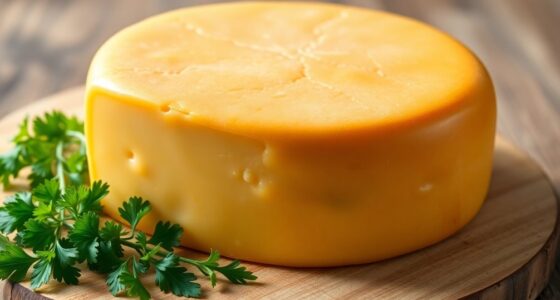Imagine walking into a cozy kitchen, the warm aroma of freshly baked Ossetian pies wrapping around you like a soft blanket. It’s a feeling that brings forth cherished memories—gathering with family, sharing stories, and enjoying delicious food that has traveled through generations. Ossetian pies, a delightful staple of traditional Ossetian food, epitomize this experience. With a rich history and a myriad of hearty fillings, these pies represent not just nourishment but a cultural bond.
In this journey, you’ll discover the best Ossetian pies to try, from cheese-laden varieties to hearty meat options. We’ll delve into authentic Ossetian recipes that showcase the unique ingredients and techniques that make these pies so special. Whether you’re looking to savor them at a local restaurant or attempting to create your own masterpiece at home, prepare to explore the delicious world of Ossetian pies like never before.
Key Takeaways
- Ossetian pies are deeply rooted in the culture of the North Caucasus.
- The key ingredients for Ossetian pie dough include flour, milk, and water.
- Various flavorful fillings like cheese, meat, and vegetables are used.
- The preparation method of these pies has been preserved over centuries.
- Ossetian pies are often served in threes, symbolizing a cultural connection.
- You can enjoy them in restaurants or make your own using traditional recipes.
What Are Ossetian Pies?
Ossetian pies, or осетинские пироги, offer a unique glimpse into the world of ossetian cuisine. These round, closed flatbreads are renowned for their thin yet robust dough, stuffed with an array of delicious fillings, making them a staple in many households and during festive occasions. The versatility of ossetian pie fillings adds to their charm, as they can accommodate a variety of ingredients tailored to personal tastes.
A Delicious Introduction to Ossetian Cuisine
The origins of ossetian pies date back centuries to the North Ossetia-Alania region of Russia. Traditionally, three pies are served on holiday tables, symbolizing God, the sun (or sky), and the earth. In contrast, funerals typically see the presentation of just two pies, highlighting the cultural significance attached to these culinary delights. Their rich history reflects the deep-rooted traditions and communal values of the Ossetian people.
Key Ingredients That Make Them Unique
To create the ideal ossetian pie, the dough-to-filling ratio is crucial, targeting approximately 1:1. Standard recipes call for 400 grams of flour, 320 milliliters of kefir, and around 300 grams of cheese. The fillings often feature hearty staples such as potatoes, wild garlic, and traditional Ossetian cheese, which is dense and salty. Alternative options like feta or pressed mozzarella might be used when necessary. The baking temperature is set at 220º C (about 450º F), with a recommended duration of 15-20 minutes, ensuring that the final product is both flavorful and visually appealing.

| Filling Options | Main Ingredients | Flavor Profile |
|---|---|---|
| Potato and Cheese | 200-250g Potatoes, 300g Cheese | Hearty and Satisfying |
| Beet Tops and Cheese | Beet Tops, Cheese | Earthy and Rich |
| Sour Cherry (Baldjin) | Sour Cherries | Sweet and Tart |
| Pumpkin, Onion & Pomegranate Molasses | Pumpkin, Onion, Pomegranate Molasses | Sweet and Savory |
| Wild Garlic and Cheese | Wild Garlic, Cheese | Pungent and Flavorful |
Ossetian pies are not just a food item; they embody the essence of ossetian cuisine and its cultural significance. Whether enjoyed as a main dish or a side, these pies are a delightful indulgence that bring people together.
The History of Ossetian Pies
Ossetian pies represent a rich tradition rooted deeply in the North Caucasus. Their history, dating back to the XII-XIV centuries, showcases the resilience and creativity of the Ossetian people during challenging times, such as the Tatar-Mongol invasion. These homemade ossetian pies reflect not just culinary skill but also cultural identity, evolving through generations while maintaining their essential characteristics.
Traditional Methods of Preparation
Crafted using shared family recipes, traditional ossetian food often employs a simple yet effective preparation method. A thin layer of dough is rolled out, typically made with ingredients native to the mountainous regions. The fillings, known for their variety, include locally available vegetables and grains, making each pie a unique expression of Ossetian culture. The introduction of yeast, eggs, and kefir has modernized this preparation, transitioning from ancient techniques while still preserving the essence of these beloved pies.
Cultural Significance in Ossetian Communities
In Ossetian communities, pies symbolize hospitality and unity, with the concept of “Three pies” representing sun, earth, and water. These homemade ossetian pies are integral to celebrations, ensuring no holiday goes without their presence. The pies also foster connections among families and friends, serving as a medium to transmit culinary traditions through gatherings and festivities. This enduring significance of ossetian pies in community life greatly enhances their value as more than mere food; they are a celebration of identity and heritage.
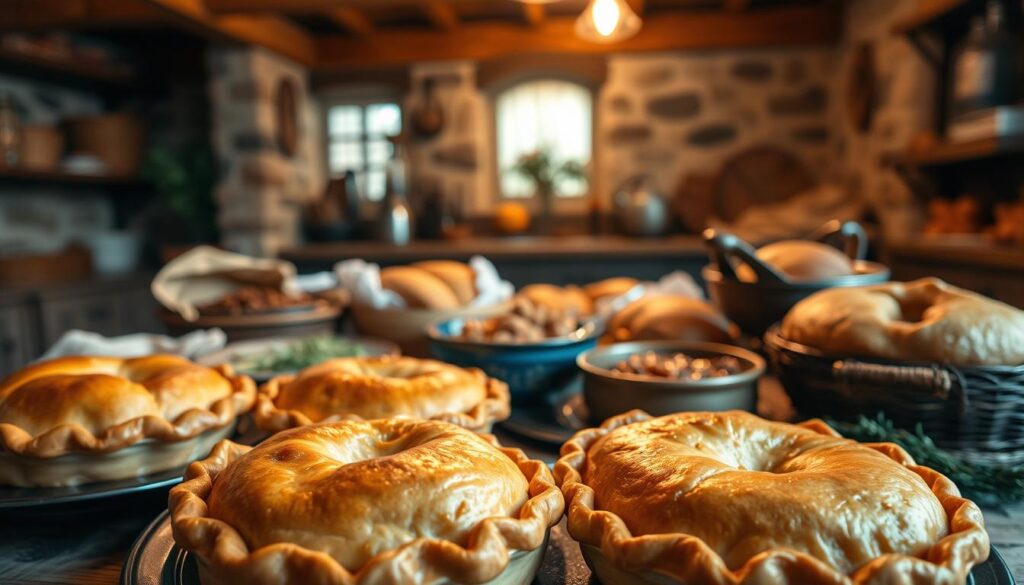
Popular Types of Ossetian Pies
Ossetian pies come in a delightful variety, each showcasing \(your\) preferences for unique flavors and fillings. The best ossetian pies not only capture traditional tastes but also offer modern twists that appeal to diverse palates. Let’s explore some popular types that you might want to try.
Cheese-Filled Ossetian Pies (Khadjyn)
One of the most beloved varieties, cheese-filled ossetian pies, or Khadjyn, combines the rich flavors of Adygei or Feta cheese with fresh greens. This savory filling creates a comforting taste experience while showcasing the best ossetian pie fillings. The combination of flaky crust and creamy cheese will surely tantalize your taste buds.
Meat Variations You’ll Love
If you are a fan of heartier meals, the meat variations of ossetian pies are a must-try. These pies typically feature succulent lamb or beef fillings, seasoned to perfection. Each bite reveals a depth of flavor that makes these pies a standout choice among the best ossetian pies available. Whether enjoyed at home or at a local eatery, you will appreciate the richness of the ossetian pie fillings.
Veggie Options for a Lighter Bite
For those seeking a lighter option, veggie ossetian pies provide a satisfying alternative. Ingredients such as pumpkin, spinach, and mushrooms come together to create a nourishing and delicious filling. This variety maintains the authenticity of traditional ossetian food while catering to vegetarian diets. These pies ensure you can indulge in the pleasures of ossetian cuisine without feeling weighed down.
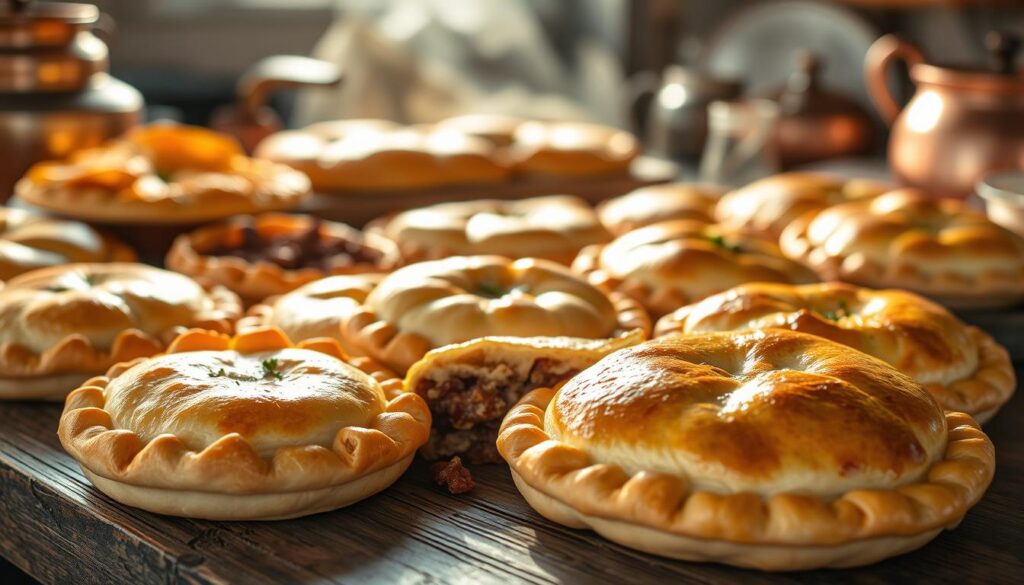
How to Make Ossetian Pies at Home
Baking homemade ossetian pies at home can be a delightful experience, allowing you to enjoy the rich flavors of this traditional dish. With the right tools and a simple recipe, you can create delicious pies that will impress family and friends.
Essential Tools You’ll Need
- Large mixing bowls
- Rolling pin
- Baking sheets
- Pie tins (preferably 20 cm in diameter)
- Measuring cups and spoons
- Knife for cutting
Step-by-Step Recipe for Beginners
Follow these steps to bake ossetian pies from scratch:
- Prepare the Dough: In a large bowl, combine 4 cups of bread flour, 2 teaspoons of instant dried yeast, and 1 teaspoon of sugar. Gradually add 200 ml of warm water, mixing until a dough forms. Allow it to rise in a warm place for approximately 40 minutes.
- Make the Filling: Cook 150g of feta cheese and 150g of mozzarella cheese, along with 1 cup of chopped spring onions, 4 cloves of garlic, and 4 onions. Sauté the onions for about 20 minutes before adding garlic for 2-3 minutes. Add 75g of butter and season with a tablespoon of finely chopped coriander or dill.
- Shape the Pies: After the dough has risen, divide it into three pieces (each about 6 ounces). Roll each piece into an 8-inch round. Place filling in the center and fold sides over, cutting a slit on top.
- Bake the Pies: Preheat your oven to 425°F (220°C). Lay the pies on baking sheets and bake for 20-25 minutes until they have a deep golden color and crispy bottoms.
Enjoy crafting your homemade ossetian pies. With practice, you’ll find the process both enjoyable and rewarding!

Where to Find Authentic Ossetian Pies in the U.S.
For those looking to savor authentic Ossetian pies without the hassle of making them at home, several top-notch restaurants and specialty bakeries across the United States offer an array of delicious options. These establishments pride themselves on their commitment to traditional cooking methods and high-quality ingredients, ensuring you experience the true essence of Ossetian cuisine. Here are some amazing places to consider when wondering where to buy ossetian pies.
Top Restaurants to Visit
- Three Pies (Kiev) – This eatery has seen a surge in popularity among young people and professionals. Their menu features a variety of pies prepared with fresh, natural ingredients.
- Ossetian Kitchen (New York) – Known for its authentic ossetian recipes, this restaurant serves classic pies bursting with flavor that reflect the region’s culinary traditions.
- Hailing from the Caucasus (Los Angeles) – A top choice for fans of hearty meals, offering a diverse selection of Ossetian pies suitable for every palate.
Specialty Bakeries Worth Checking Out
- Pirozhki Delights (Chicago) – This bakery specializes in Ossetian pies and emphasizes the use of natural products with no GMOs or harmful additives.
- Caucasian Treats (San Francisco) – A bakery where you can find freshly baked Ossetian pies prepared with care, making it a must-visit for enthusiasts of traditional cuisines.
- Grandma’s Recipes (Seattle) – Famed for their commitment to authenticity, the pies here are baked using high-grade flour and quality meats, ensuring a mouthwatering experience.

Pairing Ossetian Pies with Drinks
Enhancing your experience of ossetian pies goes beyond just savoring their rich flavors. Pairing these delightful dishes with appropriate beverages can elevate your meal to new heights. Whether you’re hosting a gathering or enjoying a cozy night in, the right drinks will complement the unique tastes found in ossetian cuisine.
The Best Wine to Complement Your Meal
When it comes to wine, certain options can harmonize beautifully with ossetian pies. A crisp white wine, like Sauvignon Blanc, pairs exceptionally well with the savory flavors found in the pies filled with cheese or meat. The acidity of this wine balances the richness of the fillings while enhancing the overall dining experience. Alternatively, a fruity Merlot or a light-bodied Pinot Noir complements the heartier meat pies, creating a satisfying contrast.
Alternative Beverage Choices
If you’re looking for non-alcoholic options, herbal teas offer a soothing complement to ossetian pies. A refreshing mint tea or a floral chamomile can cleanse the palate between bites. For a traditional touch, you might enjoy a glass of ayran (a yogurt-based drink) which pairs wonderfully with the hearty flavors of these baked delights.
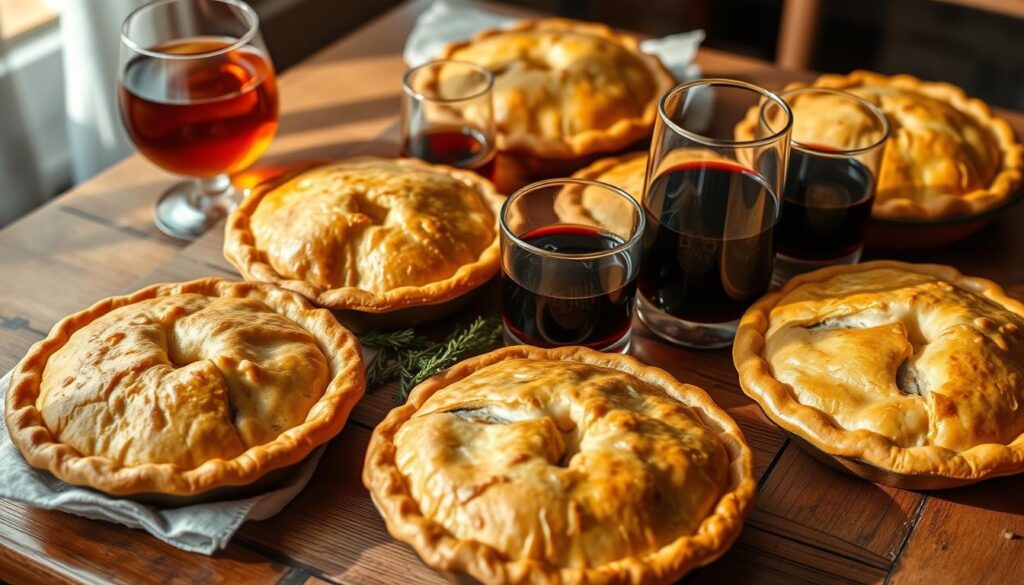
| Beverage Type | Description | Best Pairing with |
|---|---|---|
| White Wine | Crisp and refreshing, ideal for cheese fillings. | Cheese-Filled Ossetian Pies |
| Red Wine | Light-bodied with fruity notes, balances heartiness. | Meat Variations |
| Herbal Tea | Soothing and aromatic, perfect for palate cleansing. | All Ossetian Pies |
| Ayran | Traditional yogurt drink, creamy and refreshing. | All Ossetian Pies |
As you enjoy your ossetian pies, consider these beverage pairings to enhance your experience. The right drinks create a delightful balance, making your meal memorable and reflective of the rich traditions rooted in ossetian cuisine.
The Nutritional Benefits of Ossetian Pies
When it comes to traditional ossetian food, ossetian pies stand out not only for their delightful flavors but also for their impressive nutritional profile. These delicious pastries are crafted using natural ingredients, which contribute to their wholesome nature. Understanding their caloric content and the values they bring can help you appreciate how they fit into a balanced diet.
Understanding their Caloric Content
Ossetian pies feature a dough layer that accounts for approximately 30% of the finished dish. While the exact caloric content can vary based on the filling, these pies tend to provide a hearty meal without being overly heavy. They contain a comprehensive vitamin-mineral complex beneficial for overall health, enriched with various essential nutrients.
Why They Can Be Part of a Balanced Diet
Incorporating ossetian pies into your meals allows you to enjoy a range of minerals, including calcium, potassium, iron, magnesium, and iodine. Rich in vitamins A, C, E, P, K, B2, and PP, these pies make for a nutritionally balanced option. They also provide beneficial components such as fiber, amino acids, fatty acids, and lactic acid bacteria. The humorous saying in Ossetia that one pie can feed three men highlights their fulfilling nature.
Made exclusively from natural products, ossetian pies are free of harmful substances, dyes, or additives. Their quick digestion helps avoid any gastrointestinal discomfort. As versatile snacks or full meals, ossetian pies can easily be integrated into your diet. Frequent consumption is connected to prolonged health benefits, especially for men, while cilantro—a common ingredient—adds fiber and vitamins that further enhance their nutritional value.
| Nutrient | Benefits |
|---|---|
| Fiber | Stimulates gastrointestinal health |
| Calcium | Supports strong bones and teeth |
| Iron | Essential for blood health |
| Cilantro | Enhances flavor; rich in vitamins and minerals |
| Amino Acids | Building blocks for proteins |
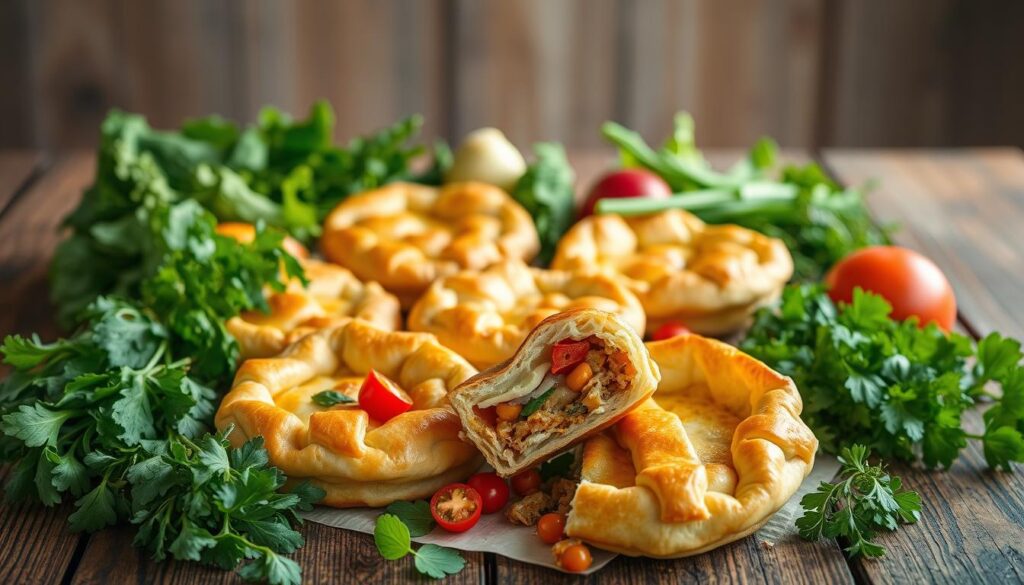
Ossetian Pies: A Fusion of Flavors
Ossetian pies are a true reflection of culinary creativity, merging traditional methods with modern adaptations. You can easily innovate by combining different ingredients to create unique flavors that remain rooted in authentic ossetian recipes. With a variety of fillings, the opportunity for personal expression in your cooking is limitless.
Combining Ingredients for a Unique Taste
Ossetian pies boast a wide array of fillings, such as cheese, potatoes, pumpkin, and minced meat. Each pie type, including Davondzhin and Kartofdzhin, showcases the delightful blend of flavors unique to the region. Incorporating local ingredients like wild garlic or kidney beans can elevate the classic ossetian pie fillings, allowing you to experiment with tastes.
Creative Twists on Classic Recipes
Fans of adventurous cooking can explore variations of traditional recipes while honoring the essence of Ossetian pies. For instance, you might substitute traditional Ossetian cheese (Earon tsykht) with alternative cheeses or introduce new herbs and spices. These modern twists ensure that every pie remains an exciting culinary experience, celebrating the rich gastronomic heritage of Ossetian cuisine.
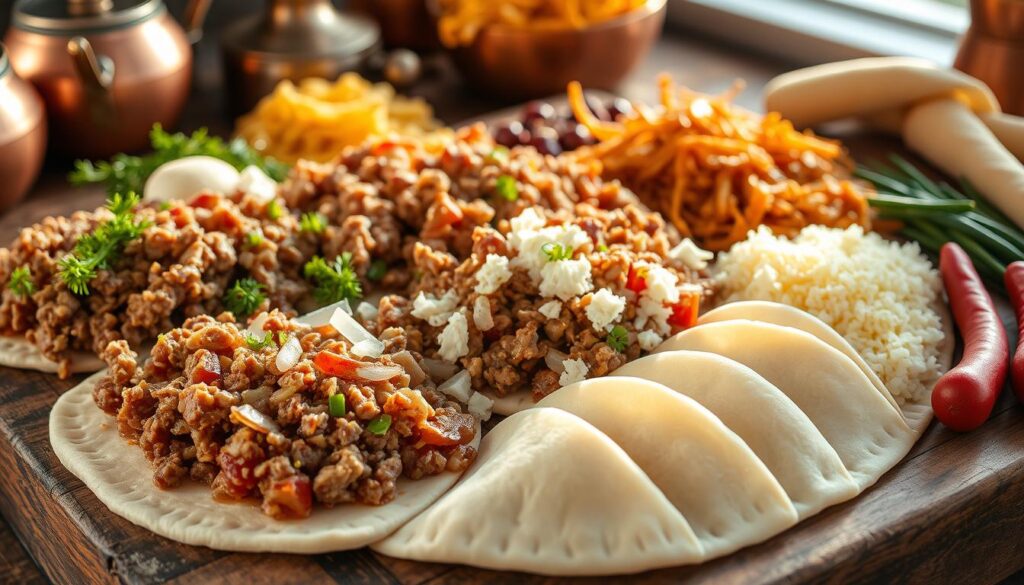
Celebrating Special Occasions with Ossetian Pies
Family gatherings and festive events bring people together, creating cherished memories. In Ossetian culture, the presence of traditional ossetian food, particularly ossetian pies, highlights their significance during these special occasions. These pies serve as a centerpiece, embodying the spirit of togetherness and celebrating cultural heritage.
Family Gatherings and Festive Events
Ossetian pies are integral to numerous celebrations throughout the year. During New Year’s Eve, families traditionally prepare three types of pies that symbolize the earth, the sun, and the sky. These large, over one-foot-diameter pies filled with rich ingredients like cheese, potatoes, and fresh herbs not only represent essential aspects of life but also bring families closer together during the meal.
Traditions Surrounding Food in Celebrations
Food plays a pivotal role in Ossetian festivities, with various unique customs linked to each occasion. Celebrations like Binati Hitsau and Hajradzhiti Ahsav involve elaborate meals featuring ossetian pies, emphasizing community bonding. These gatherings often symbolize well-being and prosperity, showcasing the significance of shared meals in maintaining family connections and honoring cultural traditions.
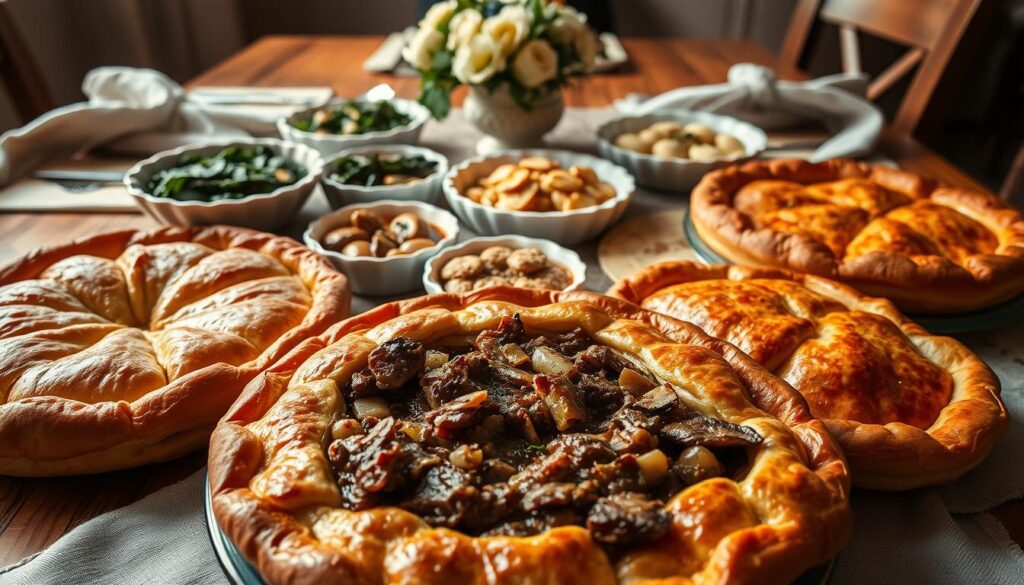
Tips for Elevating Your Ossetian Pie Experience
To truly appreciate the delightful flavors of ossetian pies, consider adding some creative garnishes and thoughtful serving suggestions. These enhancements will not only elevate the taste but also create a visually appealing presentation that celebrates the rich diversity of ossetian cuisine.
Garnishes That Enhance Flavor
Garnishing ossetian pies can significantly enhance their flavor profile. Here are some ideas to consider:
- Fresh herbs like parsley or dill add a burst of freshness.
- A dollop of sour cream provides a creamy texture that complements savory fillings.
- Chili flakes or fresh chilies can bring a delightful heat to the dish.
- Caramelized onions or sautéed mushrooms add a rich, umami flavor.
- Lemon zest can brighten the dish, especially when paired with cheese-filled ossetian pie fillings.
Serving Suggestions for Your Guests
Serve your ossetian pies in a way that showcases their unique character. Consider these serving suggestions:
- Accompany the pies with a selection of dipping sauces, such as a tangy yogurt sauce or a spicy aioli.
- Offer a light salad made of mixed greens, cucumbers, and tomatoes to provide a refreshing contrast.
- Pair with traditional drinks like Bagan, a non-alcoholic beer that complements the flavors.
- Present a variety of ossetian pie fillings, so guests can sample different flavors.
- Serve with baked potatoes or grilled vegetables for a hearty meal.

Vegan and Gluten-Free Ossetian Pie Options
Adapting traditional recipes to meet dietary preferences can be both fun and rewarding. Vegan and gluten-free options for homemade ossetian pies ensure that everyone can enjoy this delightful aspect of ossetian cuisine. With just a few ingredient swaps, you can create delicious alternatives that maintain the essence of these classic pies.
Delicious Alternatives for Everyone
When exploring vegan and gluten-free ossetian pie options, consider the following substitutions:
- Use almond or coconut flour instead of regular flour to create a gluten-free crust.
- For the filling, try substituting traditional cheeses with tofu or cashew cheese to capture the creamy texture.
- Incorporate seasonal vegetables or legumes for hearty fillings that provide ample flavor and nutrition.
Additionally, bakeries like “Pirohy Ta Druzi” feature a gluten-free poppy seed pie, offering a delicious choice for those with dietary restrictions. Creativity plays a huge role in making ossetian pies accessible to more people.
How to Adapt Traditional Recipes
Here’s a simple guide on how to adapt traditional recipes for your vegan or gluten-free needs:
- Choose your base: Opt for gluten-free flour or create a grain-free crust using nut flours.
- Select fillings wisely: Incorporate hearty vegetables and plant-based proteins for a satisfying experience.
- Experiment with seasonings: Traditional spices, garlic, and even a touch of cream made from cashews can elevate your dish.

Homemade ossetian pies allow for plenty of creativity. Bakeries, such as “People, Happiness, Pies,” create unique flavors like Tofu Cake and Italian Accent Pie. These innovations demonstrate that ossetian cuisine can embrace diverse dietary choices without losing its rich, cultural roots.
With these tips, you can confidently craft pies that not only accommodate dietary needs but also retain the beloved essence of traditional ossetian pies. Enjoy sharing these delectable creations with family and friends!
Exploring Regional Variations of Ossetian Pies
Ossetian pies exhibit remarkable diversity, reflecting the rich cultural tapestry of both North and South Ossetia. These variations are not merely about different fillings but also highlight distinct culinary traditions shaped by geography and history. Exploring these differences reveals how authentic ossetian recipes have evolved over time.
Differences in North and South Ossetia
In North Ossetia, fillings often include staples like potatoes, beet tops, and pumpkin, integrating local produce into their recipes. The use of meat is common, with hearty options that reflect the colder climate. On the other hand, South Ossetian pies may feature a wider range of fillings, such as nuts and freshly harvested vegetables, showcasing an emphasis on lighter, fresher ingredients typical of warmer climates. This delightful contrast enriches the overall experience of ossetian cuisine.
Influences from Neighboring Cuisines
The culinary landscape of Ossetian pies has been notably influenced by factors outside of its borders. Integration of elements from Georgian and Russian cuisines can be observed in the variety of spices and preparation techniques employed. Additionally, the Ossetian tradition of homemade distillates has led to exceptional local beverages that pair beautifully with pies. Rich flavors often echo the multi-ethnic background of the region, providing a deeper appreciation for the authentic ossetian recipes you encounter.

The Role of Ossetian Pies in Modern Cuisine
The revival of ossetian pies in modern culinary circles has garnered significant attention. Innovative chefs are taking traditional recipes and infusing them with contemporary techniques and flavors, making these delightful pastries more appealing to diverse audiences. As the world embraces the richness of ossetian cuisine, many are discovering the best ossetian pies, which continue to capture hearts and palates alike.
Trendy Takes on Classic Flavors
Creative chefs are reimagining traditional ossetian pies by incorporating unexpected ingredients. Classic cheese or meat fillings often receive a twist, combined with local produce or trendy spices. This experimentation invites food enthusiasts to experience the authentic taste of ossetian cuisine in an entirely new light. For instance, some establishments now offer vegan versions, ensuring everyone can enjoy these beloved pies. The thin and soft dough remains a staple, providing that comforting texture fondly associated with ossetian pies.
Why They’re Gaining Popularity
The rising interest in ossetian cuisine can be attributed to various factors. First, the dishes promote a sense of community as they are frequently served during celebrations such as birthdays, weddings, and corporate events. Reports show that when ossetian pies are present, there is a 90% chance that guests will enjoy them immensely. This social aspect, combined with a flexibility in how they can be eaten—by hand or with utensils—makes them a convenient and enjoyable option for occasions.
As urban areas see an increase in food delivery services, many people are opting for home delivery of ossetian pies. This trend promotes accessibility and helps spread awareness of these culinary treasures. Furthermore, with promotional offers boosting accessibility, more individuals are able to experience the delightful flavors of ossetian pies, leading to growing customer satisfaction. This influx emphasizes the significance of ossetian pies not just as food, but as an integral part of modern dining experiences.

Frequently Asked Questions About Ossetian Pies
Understanding ossetian pies can be a delightful journey filled with unique flavors and satisfying textures. Many people have questions when it comes to these traditional delights. This section addresses some common concerns and myths surrounding ossetian pies, while also offering practical tips for those new to this exquisite dish.
Common Concerns and Myths
- One might wonder if making authentic ossetian recipes is too complicated. The truth is, with the right guidance, anyone can create these delicious pies at home.
- Another common myth is that ossetian pies are only for special occasions. While they make great festive treats, they can also be enjoyed anytime for a flavorful meal.
- People often question the freshness of the fillings. Using high-quality, fresh ingredients is the key to achieving that irresistible taste found in authentic ossetian recipes.
Tips for First-Timers
If you are trying your hand at making ossetian pies for the first time, here are some helpful guidelines:
- Start with a simple filling like potato and cheese (kartifdjin). This combination is not only delicious but also forgiving for beginners.
- Ensure even distribution of fillings to avoid uneven cooking. A common feature of ossetian pies is their high filling-to-dough ratio, enhancing flavor and texture.
- Don’t hesitate to experiment with different fillings. From beet tops and cheese to pumpkin onion & pomegranate molasses, there’s a world of variety waiting to be explored.

Learning More About Ossetian Culinary Traditions
Diving into the world of traditional Ossetian food unlocks a treasure trove of recipes and cooking techniques. Whether you’re looking to enhance your culinary skills or simply explore the rich culture of Ossetian cuisine, numerous resources can guide you. Traditional homemade Ossetian pies are both delicious and an essential part of the culinary landscape, so let’s explore some educational avenues.
Resources and Cookbooks to Explore
- The Art of Ossetian Cooking: A comprehensive cookbook that features authentic recipes for homemade Ossetian pies, alongside other traditional dishes.
- Culinary Traditions of the Caucasus: This book explores the rich gastronomic heritage of the region, offering insights into ingredients used in traditional Ossetian food.
- Online Culinary Forums: Participate in discussions with fellow food enthusiasts who share a passion for traditional recipes and tips on making homemade Ossetian pies.
Classes and Workshops in Your Area
Consider enrolling in cooking classes focused on Ossetian cuisine. Local culinary schools and community centers often offer workshops where you can learn the art of preparing traditional pies. Engaging with experienced chefs will provide valuable hands-on experience and tips that you won’t find in a book.
| Type of Class | Location | Details |
|---|---|---|
| Ossetian Pie Workshop | Local Culinary School | Hands-on experience with dough preparation and filling. |
| Cultural Cuisine Class | Community Center | Focus on various traditional Ossetian dishes. |
| Private Cooking Lessons | At Home | Personalized guidance on making homemade Ossetian pies. |
With these resources, you can deepen your understanding of traditional Ossetian food and master the art of creating delightful homemade Ossetian pies. Enjoy your culinary journey!

Embrace the Flavor: Your Ossetian Pie Journey Awaits
As you explore the world of Ossetian pies, prepare to indulge in a culinary adventure filled with rich flavors and textures. Whether you opt to try your hand at making these delightful treats at home or seek out the best Ossetian pies at local establishments, each experience promises to be satisfying. The combination of savory fillings and earthy crusts makes them a standout dish in any setting.
Encouragement to Try Making or Tasting Them
Don’t hesitate to dive into the process of crafting your own Ossetian pies. Gathering ingredients and following traditional recipes can be a rewarding experience, allowing you to connect with the heart of Ossetian culture. If cooking is not on the agenda, visiting restaurants specializing in these pastries will surely delight your palate with their authenticity and flavor. Each bite tells a story and celebrates culinary heritage.
Final Thoughts on Enjoying this Delightful Dish
In conclusion, savoring Ossetian pies is more than just a meal; it’s about embracing the joy of discovery. Whether you relish a cheese-filled Khadjyn or explore the varied meat and veggie options, every taste transports you to the Ossetian highlands. Enjoying this delightful dish opens up an array of flavors and experiences that beckon you to continue your culinary journey.



